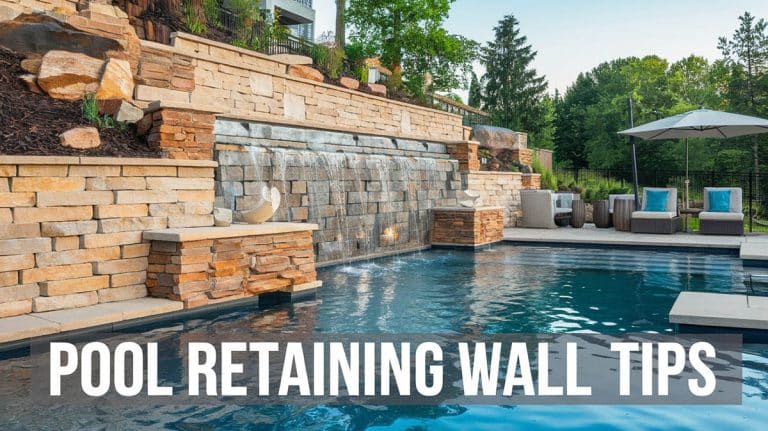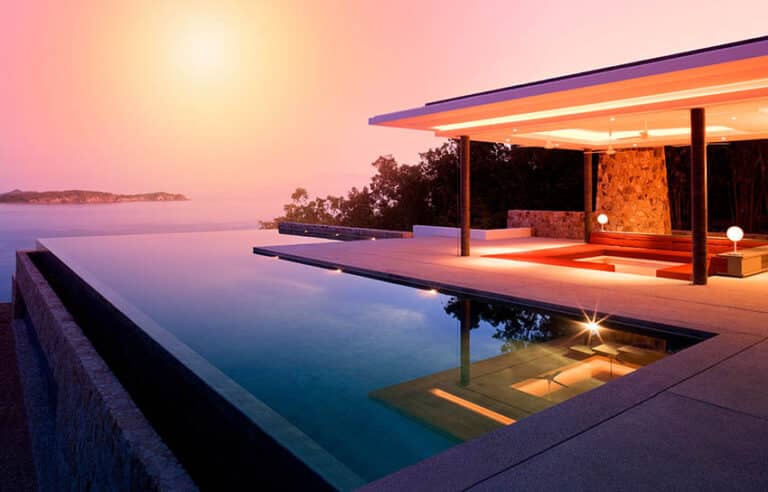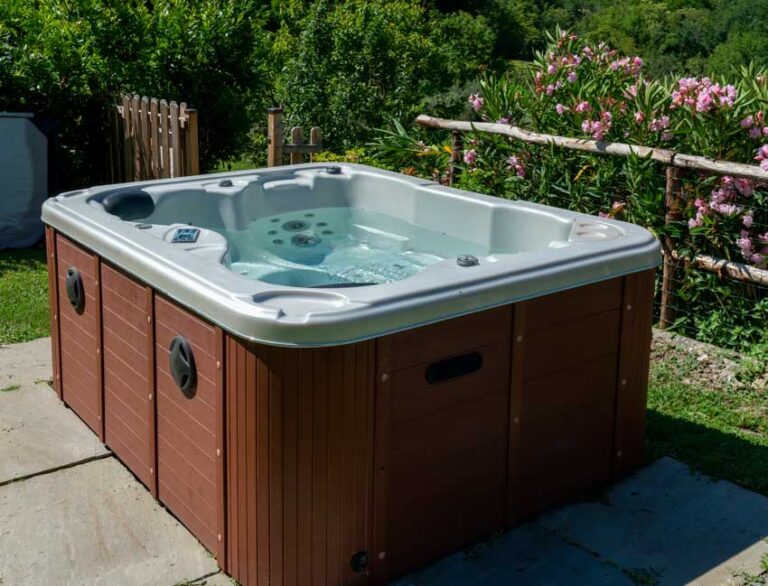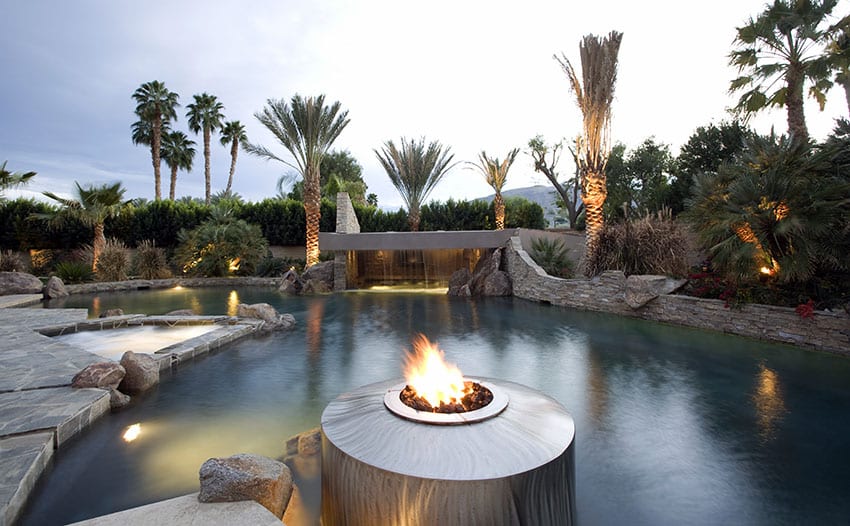Types Of Pool Liners (Designs & Pros and Cons)
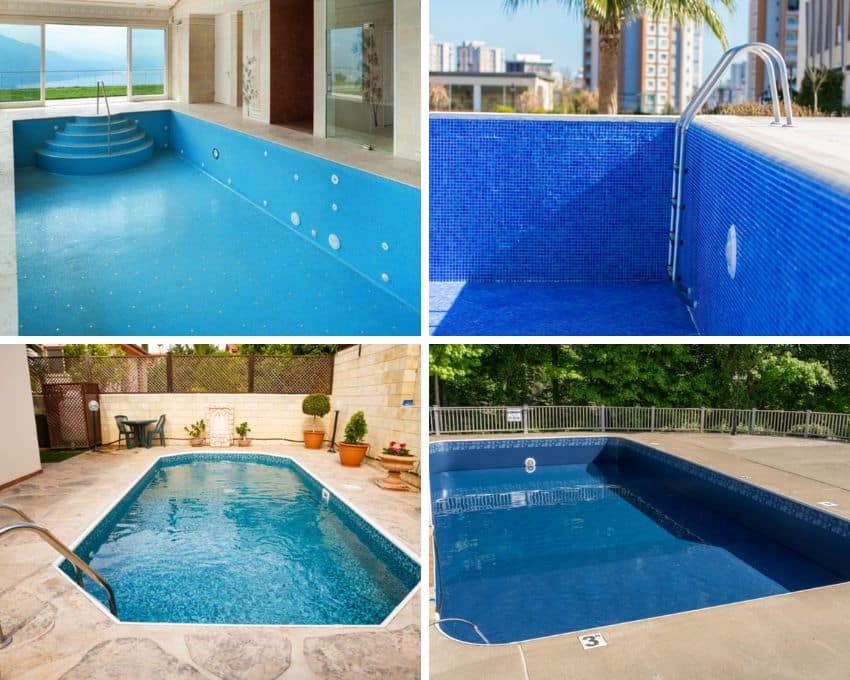
Changing pool liners, especially the first time doing so, can be confusing. There are so many times of pool liners available in the market right now. The main difference among them is actually in how they are attached to the pool. There are some pool linings that are best for a deeper section of the pool, whereas there are others that are much better suited for a flatter pool floor. In order for you to make an educated choice, it’s important for you to know what merits each type of pool liner offers and their significant pros and cons.
Quicklook: Different Liner Types For Swimming Pools
- Overlap
- Expendable
- Beaded / Hung
- J-Hook
- Uni-bead
- Inground Vinyl
What Is A Pool Liner?
Pool liners are particularly important because what they offer is the provision of a barrier between the water contained in the pool and its actual walls. There are lots of inground pools that are tiled and in turn, this completely eliminates the need for a pool liner, to begin with.
Pools that are installed with a vinyl liner usually have a foam cushion that serves as a buffer between the pool wall and the liner surface. It can dramatically improve the appearance of the pool and can create a much more inviting surface at the end of the day.

What you need to know about modern vinyl pool liners is that they happen to be impressively durable. The beauty is really in its material. A pool with a vinyl liner won’t be requiring as many chemicals as a concrete tiled pool would normally do.
Its surface is smooth and seamless and this can make it very difficult for algae and other types of contaminants to cause any sort of damage to your pool.
Overlap Liners
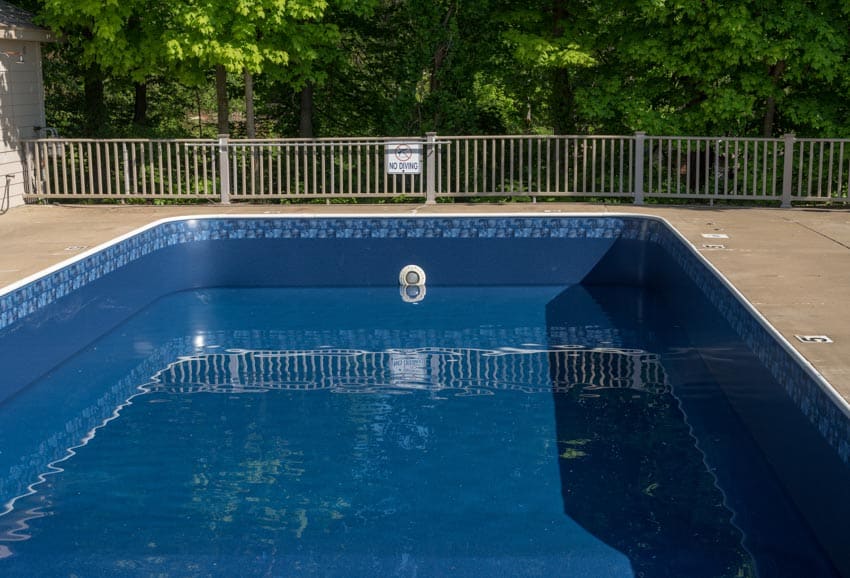
Overlap pool liners have been known to be the main type when it comes to above ground pools. Back in the 80s, overlap pool liners were all the rage. They also typically came in only one color: solid blue. Over time though, overlap pool linings have come with more patterns and other designs in them. Despite all of the progress and innovations though, classic blue still happens to reign supreme.
An overlap liner is exactly what it’s called. It is placed directly on the pool surface and is designed to have some excess provisions compared to the area surface required for the wall. Once the lining has been set in place, whatever excess material is pulled up over the wall and lain along the top of the pool, in the outside part of it. It is then secured at the top of the wall with a material called coping strips, and then the excess material is eventually cut off for a clean finish.
Benefits and Drawbacks Of Overlap Liners
Here we share the advantages and disadvantages of overlap pool liners.
Benefits
• One of the main attractions of overlap pool liners is that they cost less compared to the other types out there. If you’re on a bit of a budget, this can turn out to be an excellent choice of lining for you.
• This is also great for irregular swimming pool shapes or with issues with leveling. Poorly installed, misshapen, as well as off-level pools, can be a real challenge to deal with but overlap liners can make this so much easier.
• An overlap pool liner is versatile enough to provide varying wall heights as it all depends on how much material you actually have. It can accommodate pool heights at 48” or even 54” or higher.
Drawbacks
• Because overlap liners aren’t typically tailored to fit your pool size, you would have to handle the issue of excess material. This can at times be slightly visible on the outside area of the pool.
This can not only cover the outer design of the pool but can overall make the pool look unattractive. A solution to this would be to roll the excess material up and hide it under the top of the rails.
• This type will require coping strips. These strips will also need to be replaced every time there’s a need for you to replace the pool liner.
• This can be very hard to do yourself and you would need professionals to get the job done properly.
• If you happen to have an above ground pool that’s buried partially or even fully, it can be problematic to replace an existing overlap design.
How Long do Overlap Liners Last?
An overlap pool liner will last for a range of 5 to 8 years but the warranty coverage can range anywhere from 15 to 20 years depending on the overlap type as well as the manufacturer.
The printed ones usually have a shorter life span of 3 to 5 years but overall, it depends on how the pool is used and what type of exposure it has against the elements. It also depends on how well the pool is maintained.
Expandable Liners
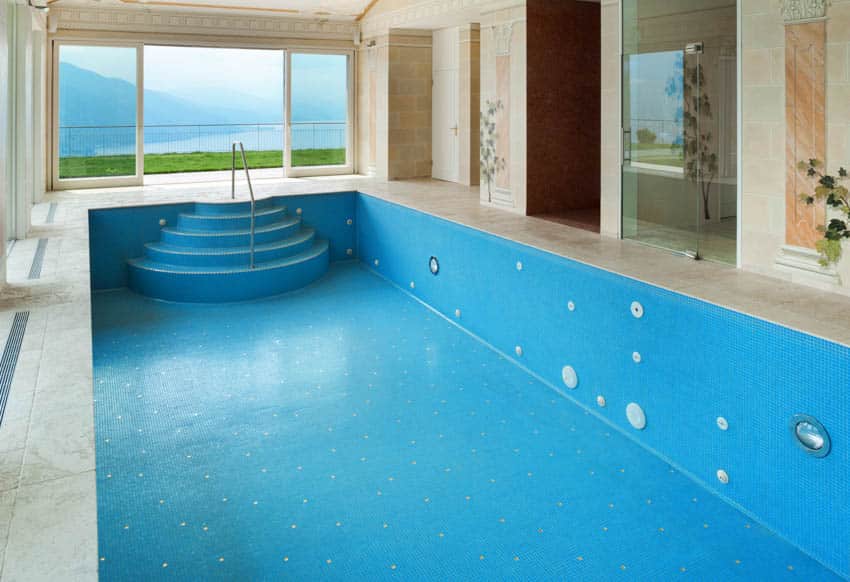
An expandable pool liner is a type that can accommodate pools as deep as 72” on the deep end. They typically come in varying stock sizes and are typically made out of 20 gauge vinyl. They are perfect for fitting Doughboy pools as well as any other pool that might require a more expansive coverage from a vinyl liner. Expandable designs are a type of overlap liner that come with a 72” wall.
Because of its extra material, it’s capable of providing coverage for deeper above ground pool types. If you have a pool with different depths or levels, an expandable pool lining can still work remarkably well as it allows itself to sit right on top of your pool floor, then extends out to the walls, and whatever excess material you have, you can actually just trim off.
Advantages and Limitations Of Expandable Liners
Here we share the advantages and disadvantages of expandable pool liners
Advantages
• They are cost-efficient. This is because they’re a type of overlap liner, which happens to be the cheapest among all the types.
• They can handle pools with irregular shapes, differing levels, or even pool finishes.
• They’re suitable for any pool height and can go as high as 72” for the pool walls.
• Its material drops down to the dug out depth which means it’s actually “stretch-to-fit”.
Limitations
• Its name can be misleading as it doesn’t actually stretch at all any more than the rest of the other liners don’t stretch. It simply has extra material for the walls that makes it seems like it can “stretch” into any pool size and type”.
• The excess material for the walls can look unattractive if not handled neatly and professionally when you trim them.
How Long Do Expandable Liners Last?
It depends on the type of pool application. Although the warranty it comes with can stretch on for 20 to 30 years, when applied inground, it can have a life span of 6 to 12 years. When applied above ground, as it’s more exposed to the elements, it can shorten by 6 to 10 years.
Beaded / Hung Liners
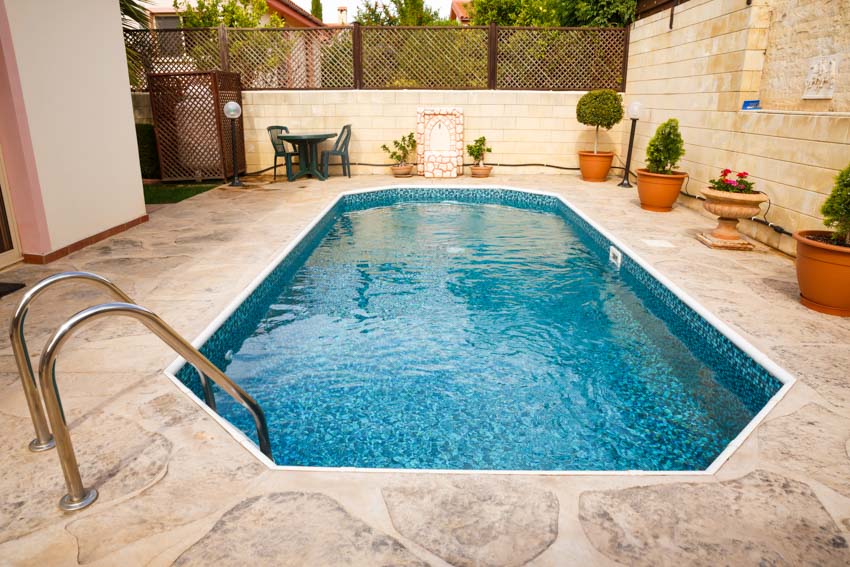
A beaded / hung pool liner is a type of pool vinyl cover whose marketing value is a featured groove that’s run along the lip of the liner’s top edge. During the installation process, this small groove is actually snapped into a track called the beaded receiver.
This is on the inside edge at the top of the pool wall. This type is known for its beautiful patterns and designs and this extends out to its tile trims as well as to its wall borders.
Upsides and Downsides Of Beaded / Hung Liners
Here we share the advantages and disadvantages of beaded/hung pool liners
Upsides
• Beaded / hung pool liners are generally more attractive or aesthetically pleasing because the lining isn’t visible on the outside walls of the pool.
• You can install or replace your beaded / hung pool liner without ever having to remove the top rails. This means that if you happen to have a deck over the top rails, there isn’t any need for you to take your deck apart just to get your pool liner changed.
Downsides
• They’re considerably more expensive compared to the rest of the other types. Some would argue that this would defeat the purpose of opting for a pool liner altogether – which is to save money.
• During installation or replacement, you have to time it right. It needs to be on a hot day when the sun is out and where the liner material can get direct heat. This is for the purpose of stretching the material out a little bit to get it installed properly.
• Although not a common occurrence, there have been occasions wherein the liner can pop out of the receiver.
• This type isn’t recommended for pools that are located in areas that have generally cold weather. This is because it doesn’t have the extra material to handle the shrinkage during cold days.
You also have to consider that when your pool ices over, the weight on the top could further pool the material down and cause it to pop out of the receiver.
How Long Do Beaded / Hung Liners Last?
Beaded / hung pool liners are known to have a life span of 10-15 years specifically because they’re more commonly used for inground pools, which lessens the material’s exposure to harsh elements. Again, there can be a myriad of factors that can contribute to the lengthening or the shortening of this life span at the end of the day.
J-Hook Liners
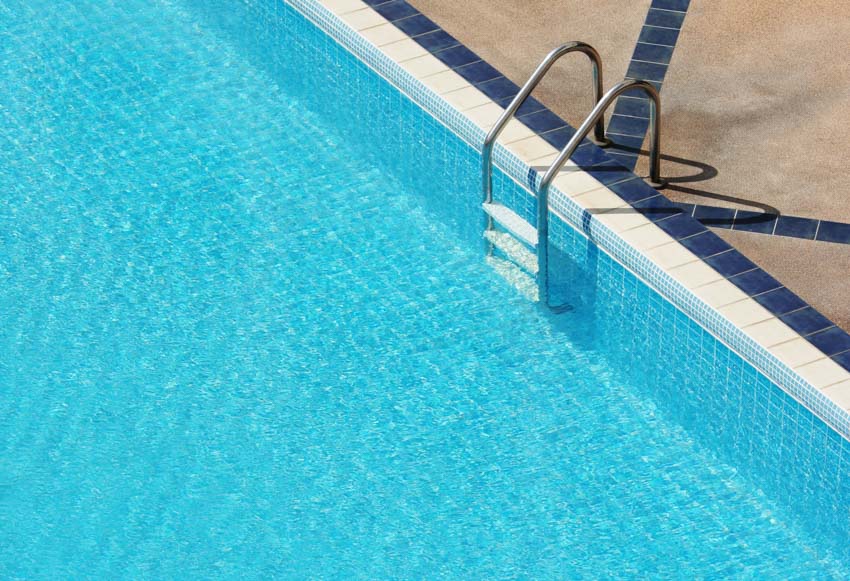
A J-Hook pool liner is a type of vinyl lining that has an upside down “J” that hooks right on the top side of the pool wall. It functions very much like an overlap vinyl lining apart from this special feature. This type is a little versatile because it can also be cut if you want to use it with a beaded receiver or coping strips. Because of its special hook, J-Hook designs can actually be used with pools without ever having a need for a bead receiver.
This J-shaped hook will take over the function of holding the liner in place once the pool is filled with water and prevent the material from slipping into the pool.
Opportunities and Challenges Of J-Hook Liners
Here we share the advantages and disadvantages of J-hook liners
Pros
• J-Hook pool liners are incredibly easy to install as all it takes is for you to put the material on the pool floor, spread it out, and hook them up to the top rails.
• It looks neat and well put together.
• There is no trimming required as the material comes measured out and has a stretched appearance and is usually pulled taut by the J-Hooks installed at the top rails.
• There is no need for a guide track as well so it makes for a much easier installation process.
• Very easy to DIY and does not require a professional to install it correctly.
Cons
• This pool liner type is recommended only for flat-bottomed pools so if you have an irregular pool type or a pool with varying ground levels, it will not be suitable for you to opt for a J-hook liner.
How Long Do J-Hook Liners Last?
A J-Hook lining isn’t known to last long so a good ballpark figure would be 2 to 5 years. It still all depends on how well you maintain the pool, what amount of element exposure it gets, and what the varying temperatures are in the area, and so on.
Uni-bead Liners
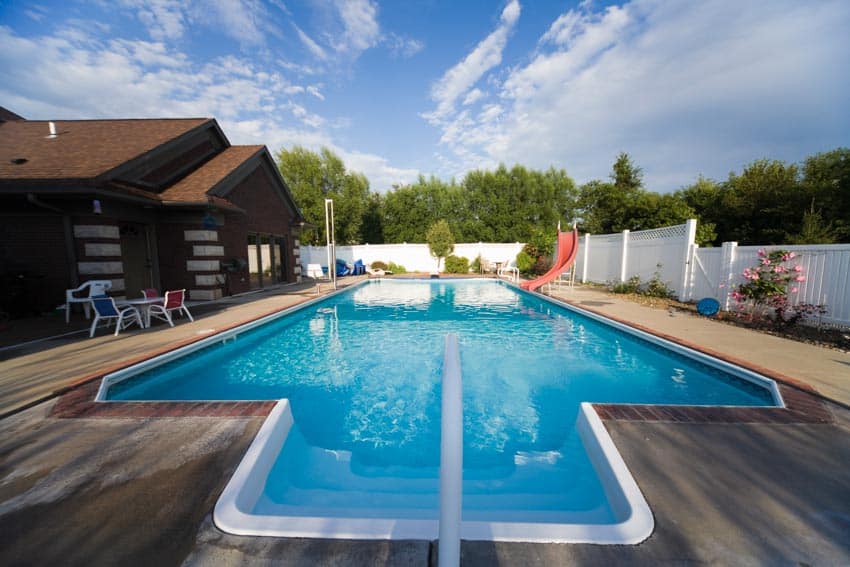
A uni-bead pool liner is oftentimes used for above ground pools. Its concept can be very similar to the concept of J-Hook designs. As a matter of fact, there are a lot of cases wherein you can actually buy a lining that’s both a J-Hook and a uni-bead pool liner.
It’s convertible, and you have all the freedom in the world to choose and pick one that will fit you and your pool needs best. In order to convert it into a uni-bead style, you only need to add a small plastic piece to your J-Hook liner.
This piece can then effectively fit into a track. This track goes around your pool wall and is responsible for keeping your liner in place. In the event that you change your mind and you want to go back to the simpler concept of the J-Hook pool liner, you can simply remove this extra plastic part.
Like the J-Hook pool liner, the uni-bead pool liner is best valued and appreciated for how good it can make your pool look.
Wins and Losses Of Uni-bead Liners
Here we share the advantages and disadvantages of uni-bead pool liners
Wins
• Like the J-Hook style, the uni-bead pool liner is incredibly easy to install. You don’t need to hire out a professional just to make sure that the job is done correctly. This is actually something that you can do yourself even if you have little to no experience with pool liners.
• It has a very attractive and neat appearance. Uni-bead options are a good choice if you are going for luxury swimming pool designs.
• It requires no trimming for the material. The material is usually tailor-fit and is “stretched” out.
Losses
• Most uni-bead pool liners don’t come with their own guide tracks so this may be something that you’d have to purchase separately.
• This type is suitable only for flat-bottomed pools. It doesn’t work well for pools that have varying depths and it may be an issue with how the material is stretched out on the bead receiver.
How Long Do Uni-bead Liners Last?
Similar to J-Hook designs, uni-bead pool liners don’t really last for very long. They have a shortened life span of 2 to 5 years compared to the other types that could stretch on for even 10 years or so.
Again, pool maintenance, element exposure, usage, and temperatures are all variables thrown into the mix of how long this design is supposed to last.
Inground Vinyl Liner
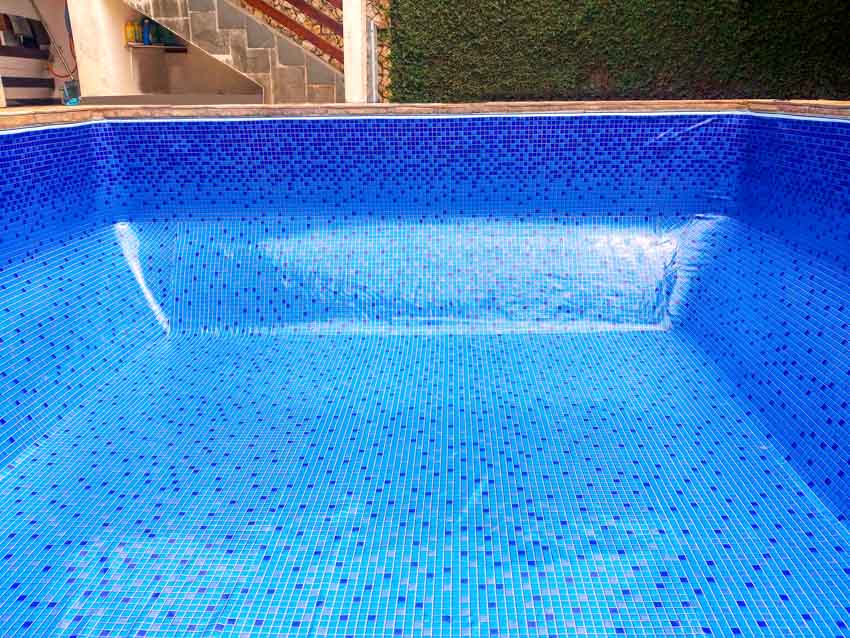
An inground vinyl liner, as the name suggests, is usually customized for specific inground swimming pool sizes and measurements. This is a liner that you would typically purchase alongside your pool purchase or pool construction.
How the material is held in place with this type is that the said material is actually pressed into the pool walls with the use of a reverse coping strip. This is a liningthat can be very specific to your pool and doesn’t really leave much room for error or excesses in the material. What this means is that there isn’t any extra trim for you to worry about or deal with.
Benefits And Drawbacks Of Inground-Style Vinyl Liner
Here we share the advantages and disadvantages of inground vinyl pool liners.
Pros
• Inground vinyl liners are very easy to install. It isn’t necessary for you to hire a specialist to get the job done. However, considering the fact that the material is taut or stretched out without a trim and usually comes along with the actual pool, it would be best for you to get your pool installers to put it on alongside your pool installation.
• It has no trim so it looks far more attractive and you don’t have to deal with the challenge of having to hide it.
• Inground vinyl liners are known to last longer to its other “more temporary” counterparts so the investment you make is sure to last you for years to come.
Cons
• Because it’s custom fit for your specific pool, this vinyl liner can usually come at a premium. It’s the most expensive type of pool liner so far as you can’t just go with something store-bought. Your pool needs to be measured out and the lining needs to be manufactured according to its specifications.
• You get less variety when it comes to the color and designs if you opt for an inground vinyl liner. You are typically offered just the classic or traditional colors.
How Long Do Inground-Type Vinyl Liners Last?
Inground vinyl liners enjoy a life span of 7 to 10 years. It depends on how you maintain the pool, what the weather conditions are in your area, and how often you use it.
Apart from the fact that this lining is custom fit for your specific pool, because the pool is inground, it also means that it has less exposure to the elements which may be one of the factors why inground vinyl installations tend to last longer.
How To Choose A Liner For Your Pool

Decide on your pattern: One of the most important decisions you will ever make when choosing a pool liner is in the pattern. This is because this is the first thing you tend to see every time you get into the pool or even just look at it.
Select the thickness of your liner: A pool liner’s thickness comes second in importance to the material’s actual fit on your pool. You need to keep in mind that the life span of pool lining doesn’t depend on how thick the material is but rather, on how good the fit is to the actual pool.
Always prioritize the pattern rather than the thickness when choosing. Here are the varying thicknesses to choose from:
• 20/20 (in millimeters): 20 for the wall and 20 for the floor is the most-recommended pool lining thickness for most locations and environments. It works great with irregular pool shapes and other add-on features that the pool might have.
• 27/20 (in millimeters): 27 for the floor and 20 for the wall. This is recommended if you want to add some more strength to your pool walls. This bears the most weight, after all. If you happen to be in an area that tends to get extended periods of freezing weather a lot, this lining thickness can be a great recommendation.
• 27/27 (in millimeters): 27 for the wall and 27 for the floor. This is a pool liner thickness that’s recommended for extreme weather and conditions. If you have issues such as having rough surfaces on your pool floor or having constant freezing weather and your lining fails you every now and then, this may be the best pool liner thickness to go for.
Check out your liner options: This is where your sense of creativity and personal style comes in. This is one of the most enjoyable things about vinyl coated pools. They offer the most flexibility in options compared to any other type of pool construction out there.
Here are some liner options to consider:
• Texture of the material
• No-tile option
• Mix & Match (patterns)
• Liners over stairs and benches
Is A Thicker Liner Better?
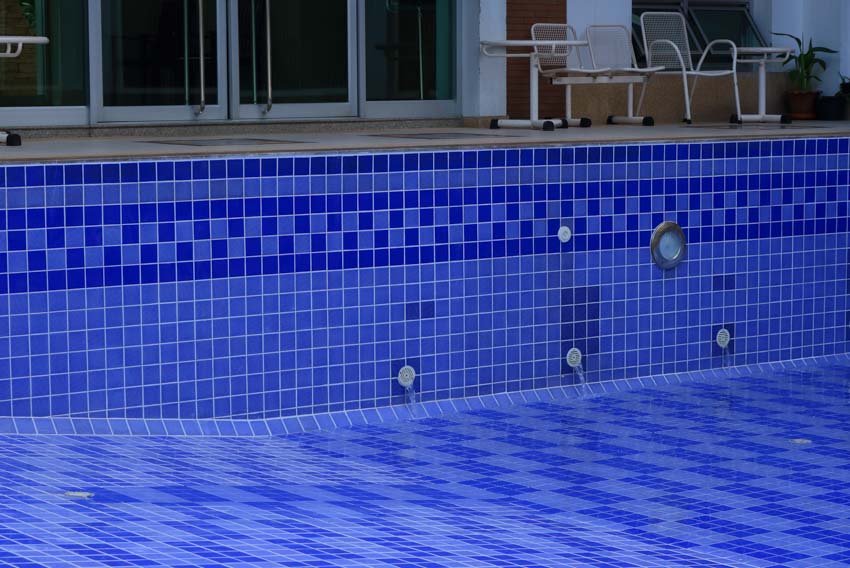
The thickness of your pool liner all boils down to a matter of preference so the initial answer to this is no. However, when you consider the conditions the pool is placed in, there may be instances wherein yes, a thicker pool lining might actually be better.
Here are a few scenarios that would benefit from a thicker swimming pool liner:
• Rough spots in the pool floor that might snag at the material
• Freezing conditions in your area that might put extra weight at the top when the pool ices over, causing the lining in your pool wall to collapse if it isn’t thick enough.
How Long Do Liners Last?
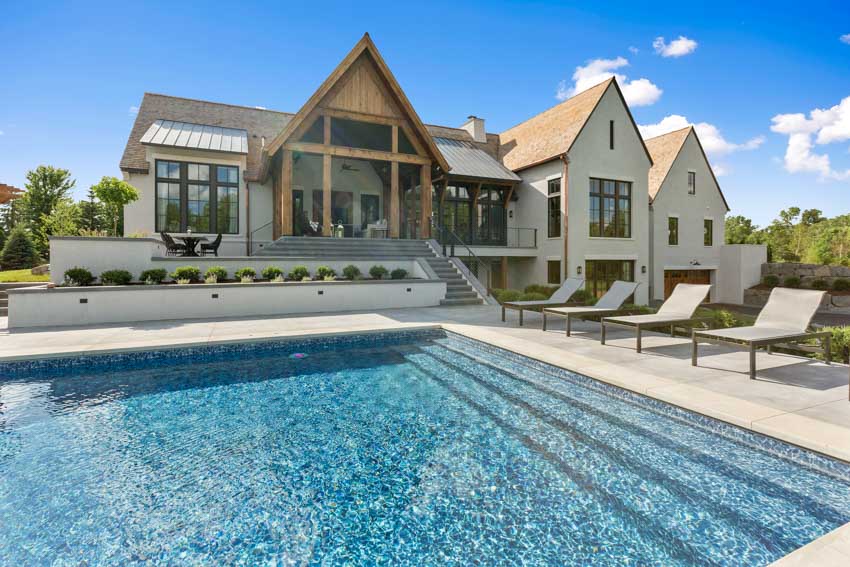
Pool liners last an average of 10 to 15 years on the positive end. However, there are plenty of factors that can actually affect its life span. It may be possible that you happen to live in an area that has issues with the quality of its groundwater.
Or you may have extreme weather conditions. You may have issues with proper maintenance and tend to neglect it. There are so many things that could factor into the life span of how long it’s supposed to last. And then, of course, is the issue of the type you have and we’ve detailed each of them above already. But in general, 10 to 15 years is a good range.
Does A Dark Liner Make Pool Water Warmer?
Yes. Dark liners do make the pool water warmer. This is all because of its reflective properties. When a lining is dark, it limits the water surface’s ability to reflect light away from the surface because instead, it absorbs it (because of the color). This increases the pool water’s temperature, making it warmer, and making it much nicer to soak in.
Will Salt Damage A Liner?
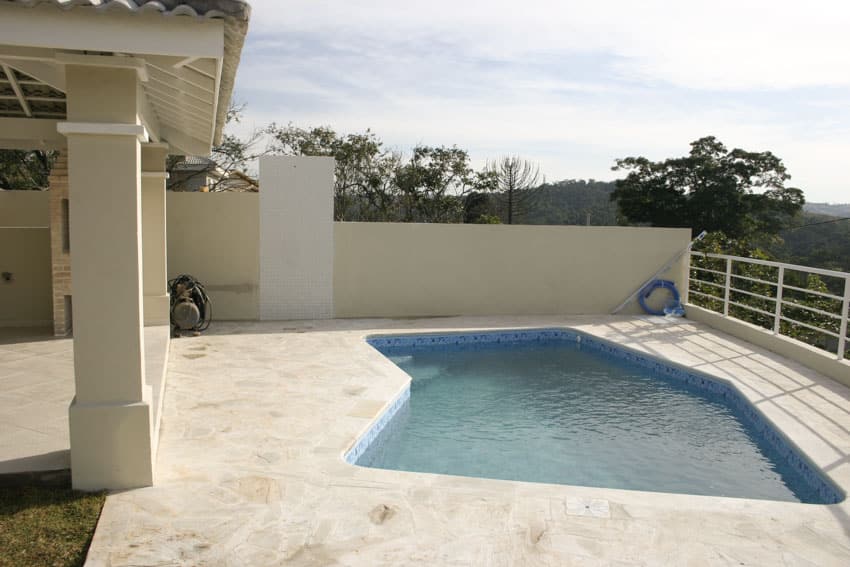
Yes. Salt is known for its extremely corrosive qualities and it can definitely wreak havoc on your pool liner, especially if not kept in check. Over time, salt can wear down the lining material. This, in turn, can result in tears or holes in which will need repair or total replacement
The moment that your lining gets tears, you have either the option to patch it up with some extra material if the holes are fairly small but if they turn out to be beyond saving already, you might not have any other choice than to replace the entire pool liner. If a typical pool liner has a life span of 10- 15 areas, under saltwater, it may shorten it to 5 to 9 years.
What Color Liner Is Safest?
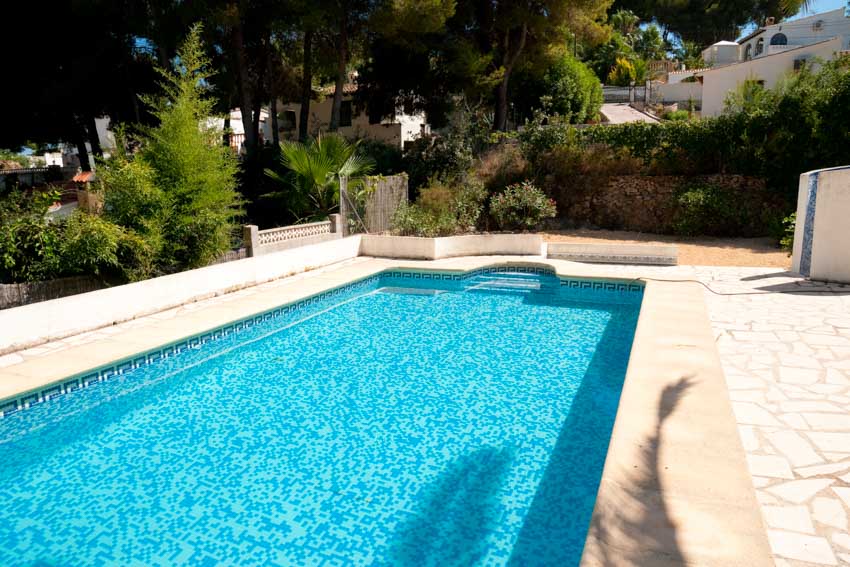
Deep blue. This happens to be the safest color and, it turns out, is also fairly convenient and efficient. More than that, this is the color that people associate the most with swimming pools. Probably because water is generally related to the color blue. You need to keep in mind that the color of your liner will set the stage when it comes to the overall feel and effect of your pool.
Another reason why blue is the safest pool color to go with is that deep blue actually absorbs sunlight. This can help tremendously in warming your pool water up. However, over time and with its exposure to chemicals, its deepness could fade out. You also need to factor in its extreme exposure to the sun. And this leads us to our second safest color, which is light blue.
A light blue lining will not show signs of degradation via bleaching and fading out as much as the dark blue will. This is why this color comes in second as a safe pool material color. Other similarly safe color choices are vibrant blue or aquamarine.
Is It Better To Have A Dark Or Light Liner?
It’s always better to have a darker-colored pool liner. Darker colors are great at absorbing heat because it minimizes the water’s ability to reflect the heat and sun rays back into the atmosphere. Instead, it absorbs into the water, effectively warming it up. A lighter-colored material, on the other hand, may radiate the light and heat out, resulting in an energy loss and ultimately, cooler pool water temperatures.
Dark linings are also great at hiding dirt or debris in the pool. It also hides imperfections such as scratches and mars better than the lighter colors can. It makes it less easily noticed.
What Can Damage A Liner?
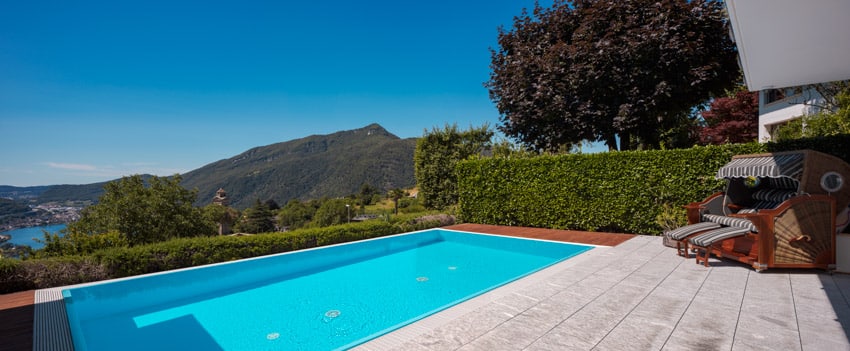
Over-using or under-using chemicals: Chlorine levels, bleach, frequent shocks, and the like can keep your pool clean but overusing them can end up damaging your pool liner. Some of the most common issues they can cause would be corrosion, staining, fading in color, and making it turn brittle.
In the same way, under-using them will lead to problems when it comes to your pool’s sanitation and water quality. It can lead to algae and bacteria growth and this can cause your lining to fade and stain as well. Always make sure that you religiously keep a close eye on your pool water chemistry. Here are the recommended levels below:
• pH: 7.2 to 7.8
• Chlorine: 1.0 to 2.0 ppm
• Dissolved solids: lower than 5000 ppm
• Calcium hardness: 180 to 220 ppm
• Alkalinity: 80 to 120 ppm
• Chloramine: lower than 0.4 ppm
• Cyanuric acid: 40 to 80 ppm
Draining your above ground pool: You need water pressure and gravity in order for you to effectively hold your pool liner in place. Without these elements, your lining may rise, shrink, or have all sorts of problems.
Completely draining your above ground pool out could cause permanent damage to your pool liner and should only be done during the process of replacing your old material.
Small holes or tears in a vinyl liner can be repaired by anyone with handy tendencies, often without draining the water. Vinyl-repair kits are available from pool dealers. They include vinyl patches and underwater adhesive. – What Color Is Your Swimming Pool? A Homeowner’s Guide to Trouble-Free Pool, Spa, and Hot Tub Maintenance, Alan Sanderfoot
This should also be done under the close supervision of a pool professional. A lot of repairs and maintenance can be done without completely draining the pool.
Neglecting leaks: The moment that something happens to your liner, you need to repair or replace it quickly or right away. Leaks are a headache to locate but the longer you let them go on, the more you won’t be able to easily patch the lining up. Leaks that have been neglected could not only leave major damages to the covering, but to your yard, pool parts, pool pump, and so much more.
Sharp objects: Pool liners are incredibly sensitive so you need to be careful about having sharp objects around the pool. They can cause tears, rips, and all sorts of damage to your enclosure when left unchecked. This includes but is not limited to toys, debris, sticks, glass, stones, and so on.
Heat sources such as fireworks, sparklers, and candles: Open flames around your pool area may not be a good idea for your lining as the heat can burn, melt, or leave scorch marks if they happen to get too close. This also applies to smoking or having a barbecue grill nearby.
Leaving the pool uncovered: Pool covers are essential for the protection of your pool. They are your first line of defense against debris, the weather, or even the scorching heat coming from the sun. always make it a point to cover your pool whenever it isn’t in use.
Wild animals: Wild animals are notorious for getting themselves trapped in your pool and they end up damaging the material in their attempt to claw themselves out. This is common for homes that happen to be in rural areas.
To minimize this, make it a point to leave your pool covered when not in use. Don’t leave food items in the pool area, and remove any stairs or ladders that might aid the wild animals in entering your pool.
Improper swimwear: Change into a bathing suit or trunks whenever you get into the pool. Make sure that everybody else will observe these rules as well.
Miscellaneous objects from regular clothing such as buttons, zippers, clasps, and the like can end up damaging your lining if they accidentally rub up against it.
How Long Does It Take To Install A Vinyl Liner?
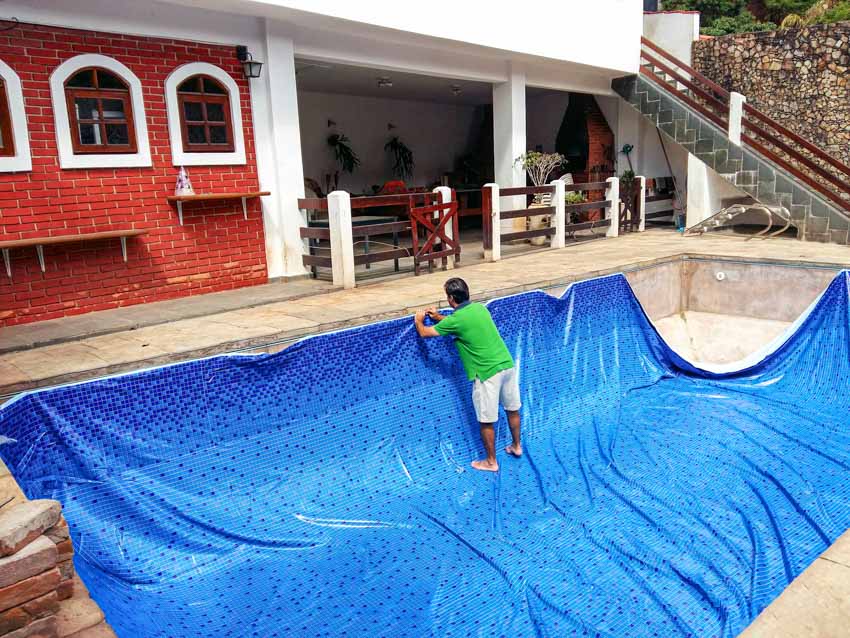
The installation for liners takes about 2 to 3 weeks. Prior to the installation itself, you will have to deal with the task of removing gaskets and faceplates, getting the lining installed and secured, then replacing them.
What Is The Most Popular Liner Design?
We’ll go with the main answer we put up above which is deep blue. And this can come tiled or un-tiled. Deep blue is associated with pristine and holiday-like clear waters and it really is no big surprise why a majority of pool owners favor this color. The color’s heat-absorbing properties are also a plus.


